Coronavirus (COVID-19): state of the epidemic - 18 March 2022
This report brings together the different sources of evidence and data about the Covid epidemic to summarise the current situation, why we are at that place, and what is likely to happen next.
This document is part of a collection
Estimated Infection Levels and Case Numbers
Estimated Infection Levels
The reproduction number (R) is the average number of secondary infections produced by a single infected person. If R is greater than one the epidemic is growing, if R is less than one the epidemic is shrinking. The higher R is above one, the more people one infectious person might further infect other people and so the faster the epidemic grows. Please note that R is an indicator that lags by two or three weeks. For more information please visit the UK government website.
The UK Health Security Agency's (UKHSA) consensus estimate for R in Scotland as at 1 March is between 1.0 and 1.3. Both the lower and upper limit of the R value have increased since the last published figure (Figure 1)[3] [4].
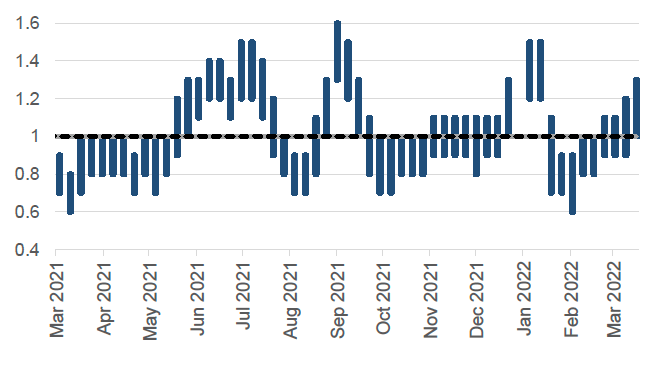
As at 1 March, the UKHSA's consensus view was that the incidence of new daily infections in Scotland was between 278 and 692 per 100,000 people. This equates to between 15,200 and 37,800 people becoming infected each day in Scotland[6].
The growth rate reflects how quickly the numbers of infections are changing day by day. It is an approximation of the percentage change in the number of new infections each day. More information can be found on the UK government website.
The latest growth rate for Scotland as at 1 March was between -1% and 3%. The upper growth limit has increased since the previous week, and the lower growth limit has remained unchanged[7] [8].
Wastewater Estimates
The Scottish Government has been working with the Scottish Environment Protection Agency (SEPA) to detect and analyse fragments of Covid-19 virus RNA in wastewater. The number of locations where the levels of SARS-CoV-2 in wastewater are monitored has increased to 141 sites around Scotland. In contrast to Covid-19 case records, virus shedding into wastewater is a biological process. This means that wastewater data is unaffected by factors that impact whether testing is done.
Nationwide, wastewater Covid-19 levels have shown a rapid increase in the most recent week. The week ending on 15 March saw levels of 206 million gene copies per person per day (Mgc/p/d), which is almost three times higher than two weeks prior (71 Mgc/p/d) (Figure 2)[9]. The increase in wastewater Covid-19 levels was seen in the majority of local authorities in Scotland, with only one local authority (Inverclyde) seeing a decrease in the week to 15 March compared to the week ending 8 March. Please note that comparisons for Na h-Eileanan Siar, Shetland Islands and Orkney Islands are not possible due to missing data in the week to 15 March.
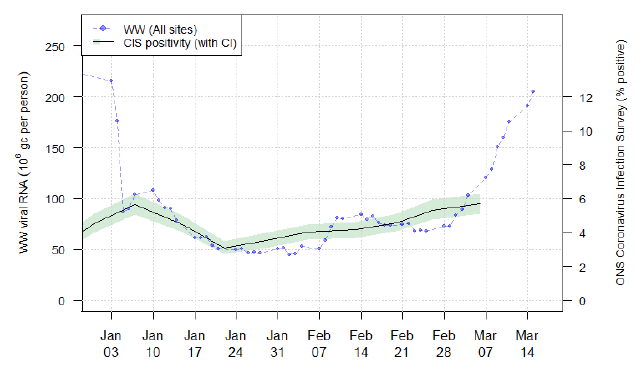
Covid Infection Survey
The Covid-19 Infection Survey is a UK wide study carried out by the Office for National Statistics (ONS) and the University of Oxford. The survey invites private residential households to test whether they have the infection, regardless of whether they have symptoms, using a PCR test. Participants are also asked to provide a blood sample to test for antibodies. This means the study is unaffected by testing policy in early 2022.
In Scotland, the percentage of people testing positive for Covid-19 as estimated by the Covid Infection Survey continued to increase in the week ending 12 March 2022, as seen in Figure 3[13]. Meanwhile, the case rate (including reinfections) by specimen date has also continued to sharply increase in Scotland in the week to 12 March. This increase in estimated infection levels in Scotland has correlated with the increasing prevalence of the Omicron BA.2 variant in Scotland since early February.
The estimated percentage of people testing positive for Covid-19 in the private residential population in the week 6 to 12 March in Scotland is 7.15% (95% credible interval: 6.56% to 7.79%)[14], equating to around 1 in 14 people (95% credible interval: 1 in 15 to 1 in 13). This is the highest estimated percentage of people testing positive since the survey began in October 2020. The previous peaks in Scotland recorded 2.29% in the week to 11 September 2021, 1.24% in the week to 17 July 2021, and 5.65% in the week to 7 January 2022[15].
In the week 6 to 12 March 2022, estimates for the other nations of the UK are as follows and can be seen in Figure 3:
- In England, the percentage of people testing positive has continued to increase in the most recent week. The estimated percentage of people testing positive is 4.87% (95% credible interval: 4.72% to 5.02%), equating to around 1 in 20 people (95% credible interval: 1 in 20 to 1 in 20).
- In Wales, the percentage of people testing positive continued to increase in the most recent week. The estimated percentage of people testing positive is 4.13% (95% credible interval: 3.56% to 4.77%), equating to around 1 in 25 people (95% credible interval: 1 in 30 to 1 in 20).
- In Northern Ireland, the percentage of people testing positive has increased in in the most recent two weeks, but the trend is uncertain in the most recent week. The estimated percentage of people testing positive is 7.12% (95% credible interval: 6.17% to 8.13%), equating to around 1 in 14 people (95% credible interval: 1 in 16 to 1 in 12).
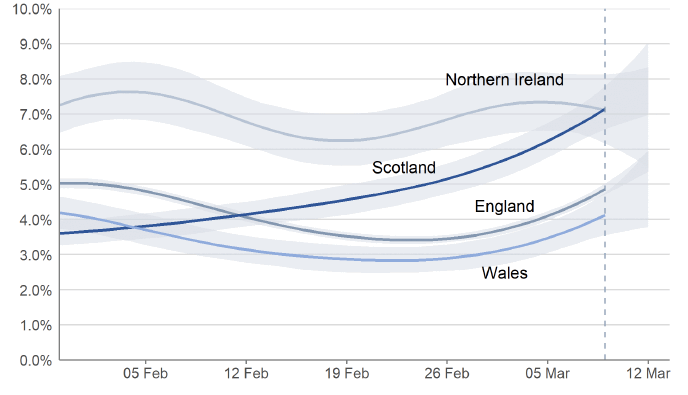
In Scotland, the estimated proportion of people testing positive increased for children of secondary school age, for young adults and for older age groups in the week to 12 March 2022. The trend is uncertain for children of nursery and primary school age in the same week[16]. Meanwhile, the case rates (including reinfections) by specimen date increased sharply in all age groups in the week to 12 March compared to the previous week[17].
Omicron BA.2
The Omicron variant was first detected in Scotland on 29 November 2021[18]. It had a growth advantage over the previously dominant Delta variant, but a lower clinical severity. The parent variant (Pango lineage B.1.1.529) can now be separated into three main groups: BA.1, BA.2 and BA.3. While the BA.1 lineage of Omicron was originally dominant within Scotland, the BA.2 is now the dominant variant and its incidence is increasing. The latest BA.2 risk assessment update issued on 25 February indicates that BA.2 has a growth advantage compared to BA.1; however, it is likely that the clinical severity of BA.2 is similar to that of BA.1[19]. The increasing prevalence of BA.2 has correlated to increasing Covid-19 prevalence in Scotland since mid-February.
According to estimates from the Covid-19 Infection Survey, the proportion of people with Covid-19 infections compatible with Omicron BA.2 in Scotland continued to increase in the most recent week to 12 March, while the percentage of people with infections compatible with Omicron BA.1 decreased in the most recent week (Figure 4). The Covid Infection Survey estimated that 5.20% (95% credible interval: 4.67 % to 5.76%) of the private residential population would test positive with a Covid-19 infection compatible with BA.2 on 9 March[20].
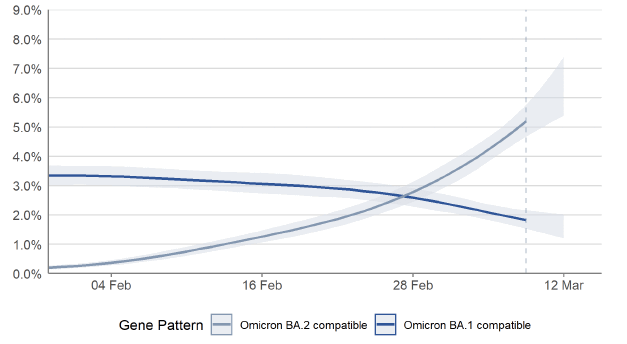
Unlike Omicron BA.1, BA.2 does not contain the deletion that leads to S Gene Target Failure in a widely used PCR testing platform available at UKGov Pillar 2 Lighthouse Laboratories. This is used as a reasonable proxy to track BA.2 as opposed to BA.1. UKGov laboratories process around 85% of PCR tests in Scotland, and of the new cases in Scotland that were notified on 11 March from UK Government laboratories, 84.2% were S gene positive[22].
Details of risk assessments for both BA.1 and BA.2 carried out by UKHSA can be found on the UK government's website[23] and in the State of the Epidemic reports published on 4 February and 28 January 2022. For more information on vaccine effectiveness and Omicron BA.2, please see the Vaccine Effectiveness Against Omicron section.
Covid-19 Cases
Please note that from 5 January, the Covid-19 case definition includes cases confirmed by either a PCR or LFD test, or both. Comparisons over time need to be made with caution. For more information on the difference between reporting and specimen date, please see this earlier publication. Cases data by specimen date includes reinfections (where a person has a positive test 90 days or more since their last positive test) since the beginning of the pandemic, while cases data by reporting date includes reinfections starting from 1 March.
Please note that Public Health Scotland experienced technical issues from 12 to 14 March, meaning that no cases could be reported on these dates and were instead added to case numbers by reporting date on 15 March. Cases by specimen date were updated retrospectively. Additionally, the 16 March figure covers less than a 24-hour period and is likely to be an undercount. This affects both cases by reporting and specimen date.
Due to the recent inclusion of reinfection cases as well as technical issues affecting case reporting by Public Health Scotland, caution must be advised when looking at cases by reporting date this week. The seven-day average cases by reporting date was on a slowly decreasing trend from Mid-January until late February. Following the inclusion of reinfections when reporting daily cases from 1 March, cases by reporting date showed an increasing trend; the seven-day average increased from 8,536 cases on 7 March to 10,820 cases on 11 March (Figure 5)[24]. Due to the inclusion of reinfections this average cannot be compared to the previous weeks.
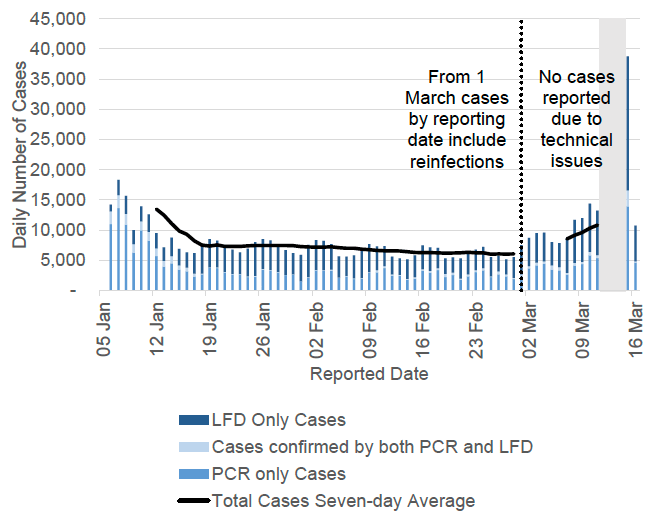
For comparisons over time it is more reliable to look at case rates by specimen date[27]. However, comparisons with data from before 5 January 2022 must be made with caution as differences are likely to reflect changes in testing behaviour and policy rather than changing infection levels alone.
Please also note that Public Health Scotland experienced technical issues with reporting on 16 March, which means that cases by specimen date from the most recent days are likely to be under reported. By specimen date, the seven-day combined PCR and LFD case rate (including reinfections) continued to increase sharply in Scotland in the most recent week. There were 1,587 weekly combined PCR and LFD cases per 100,000 population in the week to 12 March, which is a 38% increase from 1,151 weekly cases per 100,000 on 5 March, and an 84% increase from 861 weekly cases per 100,000 on 26 February. This remains a very high case rate compared to previous phases of the pandemic in Scotland (Figure 6Error! Reference source not found.)[28].
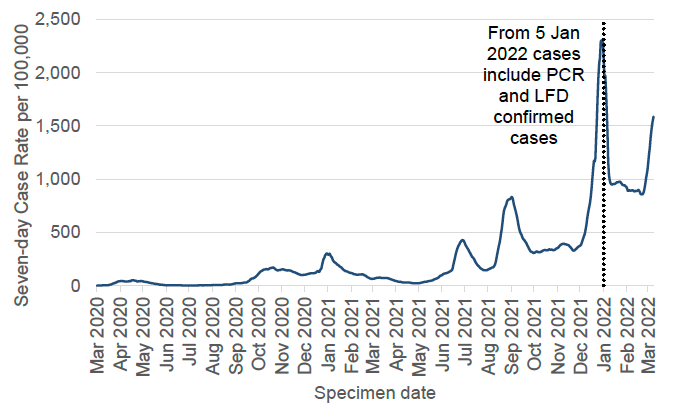
The week leading up to 12 March continued to see sharply increasing case rates (including reinfections) in all age groups compared to the week to 5 March, ranging from a 38% increase among those aged 20 to 39, to a 46% increase among those aged 19 or younger, those aged 40 to 49, and those aged 60 to 69 (Figure 7). Cases among those aged 60 or older have been increasing since early February, and in the week to 12 March this age group had a combined case rate of 939 cases per 100,000, which is a 44% increase from the week to 5 March (650 cases per 100,000), and a 128% increase from 12 February (411 cases per 100,000)[30].
Among those aged 19 or younger, the increase ranged from 39% among those aged 5 to 11, to 67% among those aged 16 to 17. This follows a period of slightly decreasing or similar levels of Covid-19 among age groups younger than 60 since mid-February (Figure 7)[31].
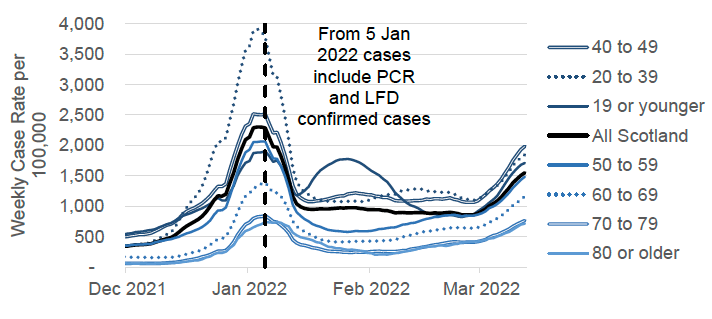
This is in line with the increasing numbers of weekly Covid-19 cases among care home residents throughout February and early March 2022. In the week to 13 March, there were 744 reported cases among care home residents, which is an increase of 24% from the previous week ending 6 March (598 cases). The number of cases in the most recent week is lower than previous peak of 833 weekly cases in the week to 9 January 2022, but higher than the peak of 641 weekly cases in the week to 10 January 2021[34].
Due to different case definitions across the UK, comparisons between countries cannot be made at this time. The four nations rely on different sets of Covid-19 tests for reporting cases. Cases data from Scotland includes PCR and LFD test results. Cases data from England includes PCR, LFD and LAMP (loopmediated isothermal amplification) test results. For both Scotland and England, positive rapid lateral flow test results can be confirmed with PCR tests taken within 48 hours and if this PCR test result is negative, these are removed as cases. Cases data from Northern Ireland includes both PCR and LFD tests results, while cases data from Wales relies only on PCR test results. Cases from Scotland, Northern Ireland and England include reinfections based on a 90-day threshold, while cases data from Wales includes reinfections based on a 42-day threshold.
Due to the different case definitions outlined above, we have not included case comparisons across the four UK nations using data from the UK Government dashboard in this edition of the report. When these definitions are more aligned we will resume reporting on these comparisons. To compare trends in estimated infection levels in private residential households across the UK, please see the previous section on the Covid Infection Survey.
Reinfections
A reinfection is defined as a positive test 90 days or more after a previous positive test. This amount of time is set in order to be able to distinguish between viral persistence of the primary Covid-19 episode and a true reinfection.
Please note, figures from 16 March cover less than a 24-hour period. This is due to a reoccurrence of the technical issue from earlier in the week, meaning data has not been received since 6 P.M. on 15 March. This means that the last couple of days for this data by specimen date is likely to be an under count.
The increase in the proportion of reinfections seen in late 2021 corresponds to the emergence of the now dominant Omicron BA.1 variant in the UK. The proportion of reinfections in Scotland when Omicron BA.1 was first detected on 29 November[35] was 0.8% percent of total cases. These are cases in individuals for whom it has been 90 or more days since their last positive Covid-19 test. The proportion of reinfections peaked on 4 January, at 9.1%, before decreasing slightly (Figure 8).
The proportion of reinfections among the total weekly cases continued to increase in the most recent week. By specimen date, there was a total number of 8,151 reinfection cases confirmed by either a PCR or LFD test in the week leading up to 12 March. These are cases in individuals for whom it has been 90 or more days since their last positive Covid-19 test. This represents 9.6% of reported cases, an increase from 9.2% in the week leading up to 5 March, and is the highest level of reinfections seen in the pandemic.
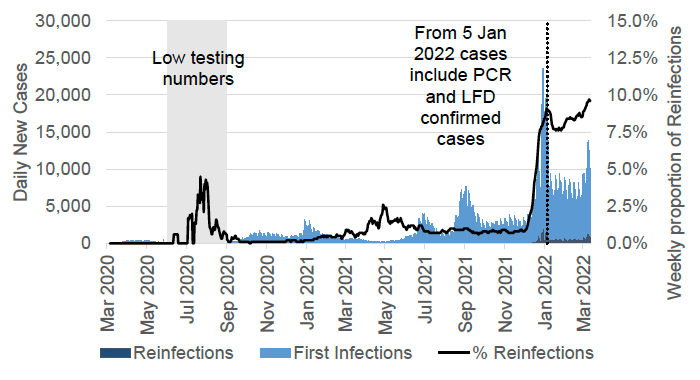
LFD Testing
The weekly number of reported LFD tests peaked on 26 December 2021 with 867,417 reported tests, and has shown a decreasing trend since[37]. However, the weekly total of tests reported in the week to 13 March increased by 3% from the previous week leading up to 6 March. There were 576,382 reported tests in the week to 13 March (Figure 9)[38].
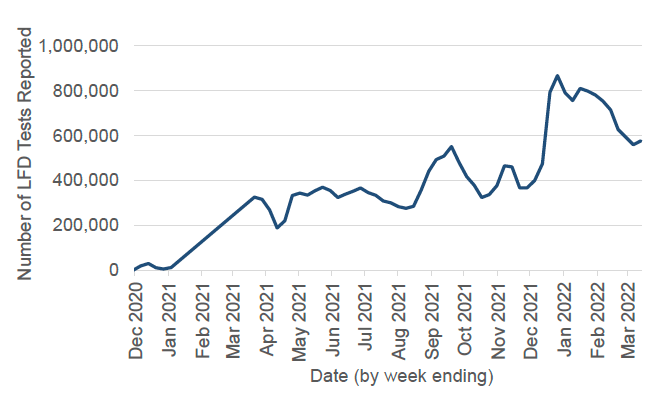
YouGov survey results have shown that on 15 to 16 March, 53% of respondents had taken a LFD/antigen test and 9% a PCR test in the past week[39]. Of those who had taken a LFD/antigen test, 44% recorded the result of their last LFD/antigen test online and 54% did not record the results online[40].
The Scottish Contact Survey asks whether people use LFD tests and if so how often. Approximately 76% of individuals had taken at least one lateral flow test within the last 7 days for the survey pertaining to the 24 February - 2 March[41].
There are differences in the results from the YouGov and the Scottish Contact Survey (SCS) which may be likely to be due to differences in sampling and methodology. YouGov is an online survey based on an active sample which is representative of the Scottish population with around 1,000 respondents[42]. The SCS[43] is based on a longitudinal survey with a larger sample of around 3,000, with the responses being modelled to represent the Scottish population.
Contact
There is a problem
Thanks for your feedback